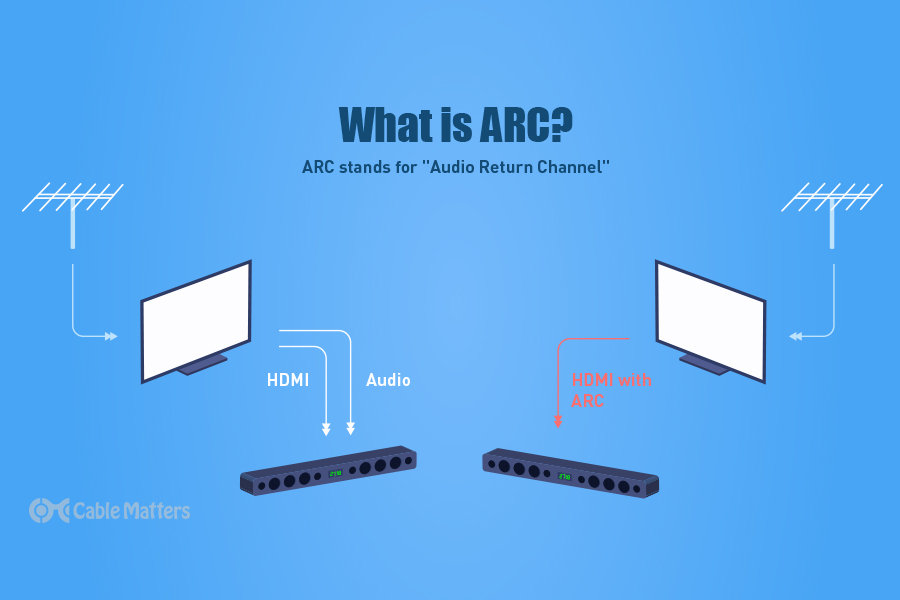
If you've ever looked at connectors on the back of your TV and wondered, "What is the HDMI ARC connector?" you wouldn't be the first. While many are familiar with the HDMI port and its corresponding cable, having used it to connect everything from DVD players to games consoles to their televisions for over 15 years, HDMI ARC isn't a well used or understood featured. But it should be.
The HDMI Audio Return Channel (ARC) simplifies a complicated home TV system that uses an external sound system to amplify the TV's audio. It's a protocol that allows the HDMI cable to act as both an upstream and downstream transmission cable. That means that instead of running an extra audio cable from your TV to your external speaker system or soundbar, you can use the existing HDMI cable that connects them to the TV.
What is ARC? It's arguably the best feature the HDMI connection has in its ongoing war with DisplayPort for the king of the media cables.
What is the HDMI ARC?
The audio return channel was originally integrated as a feature in the HDMI 1.4 specification in 2009, seven years after the debut of the original HDMI standard, its cable, and the connector. It joined advances in resolutions and refresh rate support, an incorporated HDMI Ethernet Channel (HEC), better color support, and spawned the new Micro HDMI connector.
A far less impactful update than previous and newer HDMI updates, HDMI 1.4's arguably most important feature was the addition of the audio return channel. Early adopters who wondered, what is the HDMI ARC, quickly found out that it allowed them to cut back on cabling, simplify their TV's audio setup, and even enjoy greater quality audio, too.
Before ARC, you had to connect an external device like a cable box or Blu-ray player to the A/V system, then to your TV, then run a separate optical audio connector back to the A/V system. Now you can ditch the optical cable entirely. With ARC, you can connect your media source to the A/V system over HDMI, and then the A/V system to the TV using a secondary HDMI cable. That's it.
There are two main scenarios where this stands out. The first is when you have multiple HDMI sources that you’d like to play through your A/V system. Just run the HDMI cable from TV to A/V system- no need to plug in multiple sources to the audio system. Secondly, and increasingly more relevant is on smart TVs. Smart TVs essentially create their own content (streaming Netflix, Hulu, etc.), and if you’d like to send that audio through your external speakers, then ARC is crucial since it allows audio to flow to the A/V receiver via HDMI cable.
This also opens up the potential for supporting improved audio formats. While TOSLINK optical cables can support a variety of audio formats, it's limited to two channels of PCM audio. HDMI’s greater bandwidth can support up to eight audio channels, and even 5.1 surround sound over an ARC connection, albeit in a compressed format.
It's also perfect for audio devices that only have HDMI connections and don't support the older optical standard.
Even if you aren’t concerned about audio quality, ARC is still useful and makes for a more attractive and simplified TV AV setup because it results in one fewer cable to route through a cable tidy or behind a wall.
As great as it is though, ARC does have its limitations. Some TV manufacturers only support some of its features, like lip sync correction, while others only support stereo audio and not even the compressed 5.1 surround sound offered in the HDMI specification. This has proved even more problematic with the adoption of 4K and HDR TVs, where the available bandwidth on newer HDMI standards is constricted further.
That's where ARC's sequel on the HDMI 2.1 cable, eARC, comes in (available now at Cable Matters).
HDMI eARC
As with any technology, ARC has its advances. Just as you've started to answer the question of what is the HDMI ARC, you'll also want to know what is eARC?
Like ARC, the enhanced audio return channel, or eARC, helps simplify cabling and makes the most of its bandwidth to allow for higher quality audio transmission. The eARC protocol goes one step further by leveraging the greater bandwidth of the HDMI 2.1 connection to offer an even greater array of lossless audio formats.
An HDMI 1.4 connection has enough bandwidth to handle 4K video at 30Hz, and lossless stereo sound. It can do 5.1 surround sound too, but only when compressed and it can't manage 7.1 surround sound. The HDMI 2.1 connection and its cables have enough bandwidth to support 8K resolution and much higher refresh rates for 4K. It also has enough headroom to handle entirely lossless 7.1 surround sound over eARC, as well as fantastic modern audio features like Dolby TrueHD, Dolby Atmos, DTS-HD Master Audio, and DTS:X.
The only caveat is that both your TV and A/V system will need to support HDMI 2.1 and eARC to take advantage of it. Considering both are brand new technologies only supported by a handful of contemporary devices, you're probably looking at upgrading both if you want to make use of it. The results speak for themselves, though. The HDMI eARC connector opens up an exciting new world of simplified, higher-quality, home audio.